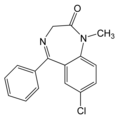Three generic versions of the tranquilizer Valium, one of the nation's most widely used prescription drugs, were approved by FDA in September. The new versions will be manufactured by Myland Pharmaceuticals, Morgantown, W.VA.; Park-Davis Division of Warner lamber Co. of Morris Plains, N.J.; and Zenith Laboratories of Northvale, N.J. Valium has been marketed by its developer, Hoffmann-La Roche, since 1963.
The latest generic approvals mean that nine of the 10 top-selling drugs in the United States are available in alternative versions , generally at much lower prices.
Generic versions of seven prescription drugs, including four of the top 10 drugs, were approved since enactment of the Drug Price Competition and patent Term Restoration Act in September 1984. The act simplified and speeded the approval of generic versions of already marketed drugs that are no longer protected by patents. (For more information on the new law and generic drugs, see "Generic Drugs: Cutting Cost, Not Corners" in the October 1985 FDA Consumer.)
In addition to Valium (known generically as diazepam), generic versions of these drugs have recently been approved: Norpace (disopyramide phosphate), Darvocet-N (propoxyphene napsylate with acetaminophen), Reglan (metaclopramide), Inderal (propranolol hydrochloride), Motrin (ibuprofen), and Ativan (lorazepam).
The 10 top-selling prescription drugs are (brand name first, with generic following): 1. Dyazide (hydrochlorothiazide-triamterene)--a diuretic/anti-hypertension drug, for which there is a generic alternative but with differences in bioavailability and potency that a physician must adjust for. 2. Inderal (propranolol hydrochloride)--for hypertension, migraine headaches, and various heart problems, for which FDA in July and August approved generic versions by three firms. 3. Lanoxin (digoxin)--another heart drug, for which generics have been available for some time. 4. Valium (diazepam)--a sedative, tranquilizer and muscle relaxer, for which the three companies have just been given approval to make generic versions. 5. Tylenol with codeine (acetaminophen-codeine)--a painkiller for which there have been generic versions since the 1970s. 6. Amoxil (amoxicillin)--for bacterial infections, for which generic versions have been available, also since the 1970s. 7. Tagamet (cimetidine)--for ulcers and other gastrointestinal conditions, approved by FDA in 1983 and still under patent. As a result, there is no generic version available. 8. Lasix (furosemide)--a diuretic with uses including treatment of mild to moderate hypertension, for which a generic version was approved in 1983 on the basis of a literature search for public data on effectiveness and safety. 9. Motrin (ibuprofen)--a painkiller and arthritis medicine, for which generic versions were approved in July and August. 10. Darvocet-N 100 (acetaminophen/propoxyphene napsylate)--a painkiller for which three generic versions were approved in June.
COPYRIGHT 1985 U.S. Government Printing Office
COPYRIGHT 2004 Gale Group



